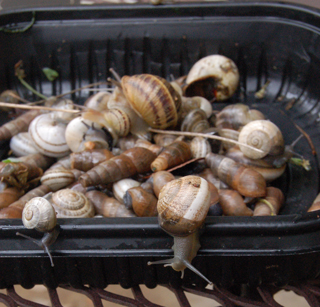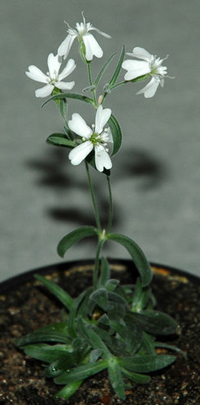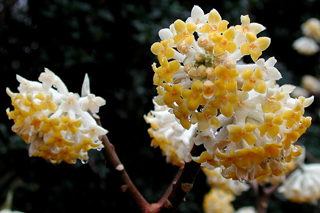Human Flower Project
Science
Tuesday, April 03, 2012
The Pollination Racket
A new study of birds finds that human noise is tough on pines but a boon to skyrocket flowers.

Will earplugs be the next trendy gardening accessory, this year’s Crocs?
New research by Clinton D. Francis and his colleagues suggest that in some environments anyway, noise may actually improve flower pollination. It’s a finding that will much dismay those of us who think of puttering outside as a respite from racket.
Francis and his team examined the effects of noise on plant pollination by setting up experimental stations at two spots within the Rattlesnake Canyon Wildlife Area in northwestern New Mexico. One location was relatively quiet, but the other was adjacent to a natural gas well operation, with big machinery and compressors at work around the clock.
Tuesday, February 28, 2012
Keeping Up with Snails
An old garden pest puts a dent in what has been predicted to be a banner year for wildflowers.

A brown garden snail and milk snail try to escape
after one of many hunts, Austin, Texas, 2/28/12
Photo: Human Flower Project
The glory days of March in Texas are nigh. After an unrelenting drought, good rains late last year and intermittent downpours over the past two months have the wildflower swamis grinning in expectation.
So were we until about a week ago, when we saw that a once-lush patch of bluebonnet plants along the front slope was taking a beating. The leaves were mangled and bitten off. Trampled by pigmy goats?
No. Along the central stalk of two big Agave americanas and deep into a razor sharp sotol, we spotted snails, scores of them, tucked away for the afternoon.
Monday, February 20, 2012
A Flower from before the Pharoahs
A plant newly grown from an ancient fruit placenta may provide a key to evolution.
 A campion plant grown from fruit tissue found frozen along a Siberian Riverbank.
A campion plant grown from fruit tissue found frozen along a Siberian Riverbank.
Photo: via New York Times
Taking a giant leap back in time, Russian plant scientists claim to have succeeded in growing a plant from tissue 32,000 years old.
The New York Times reports on the research of Svetlana Yashina and David Gilichinsky (to be published tomorrow in The Proceedings of the U.S. National Academy of Sciences).
The scientists and their team found fruit of a narrow-leafed campion plant, buried by an ancient squirrel inside the bank of the Kolyma River in Siberia.
“Working with a burrow from the site called Duvanny Yar, the Russian researchers tried to germinate the campion seeds, but failed to do so. They then took cells from the placenta, the organ in the fruit that produces the seeds. They thawed out the cells and grew them in culture dishes into whole plants.
“Many plants can be propagated from a single adult cell, and this cloning procedure worked with three of the placentas, the Russian researchers report. They grew 36 ancient plants, which appeared identical to the present day narrow-leafed campion until they flowered, when they produced narrower and more splayed-out petals.”
 David A. Gilichinsky, one of the lead scientists who found and successfully grew the ancient campion plant.
David A. Gilichinsky, one of the lead scientists who found and successfully grew the ancient campion plant.
Photo: Cryosol Working Group
Sadly, Dr. Gilichinsky died of a heart attack Saturday.
But if DNA studies and radiocarbon dating confirm the discovery, the plants that he and his team have grown would be by far the oldest plants grown from ancient seed. The previous record holder was a date palm.
Wednesday, February 15, 2012
Weaving among Hardiness Zones
Kentuckian Allen Bush pushes the limit with new plants from Florida, seduced by the USDA’s new maps.

Edgeworth chrysantha: an early bloomer, “insanely intoxicating”
Photo: W.J. Hayden
By Allen Bush
The long awaited interactive garden tool was released a few weeks before our Florida vacation. I didn’t study the new map, though I could see Louisville, Kentucky, was colored some shade of green. There were adjacent greens but I’m red-green colorblind. It was all a muddle.
On our vacation to Sanibel Island, a few weeks later, Mary Vaananen, my Jelitto colleague, emailed and announced that Louisville had been upgraded from 6b (-5 F to 0 F/-20.6 C to -17.8 C) to 7a (0 F to 5 F/-17.8C to -15 C). I started shopping for native Florida plants the next day. Florida and Kentucky have a lot in common. Florida once sat at the bottom of an ocean floor; so did Kentucky. In 1824, botanist Constantine Rafinesque wrote in Annals of Kentucky: “The briny oceans cover the whole land of Kentucky.” Kentucky was only 10 degrees north of the equator, when we were sitting under a shallow ocean in the Devonian Period 380 million years ago.

